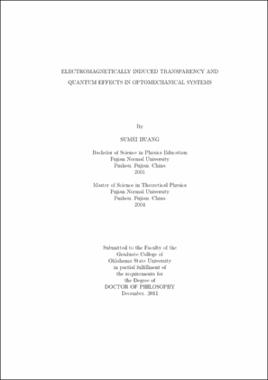| dc.contributor.advisor | Agarwal, G. S. | |
| dc.contributor.author | Huang, Sumei | |
| dc.date.accessioned | 2013-11-26T08:26:33Z | |
| dc.date.available | 2013-11-26T08:26:33Z | |
| dc.date.issued | 2011-12 | |
| dc.identifier.uri | https://hdl.handle.net/11244/6896 | |
| dc.description.abstract | In this thesis, we study cooling, normal mode splitting, squeezing, entanglement, and electromagnetically induced transparency in the macroscopic optomechanical system. We show that a type I optical parametric amplifier in a Fabry-Perot cavity can considerably improve cooling of a mechanical oscillator, and it also can affect the normal-mode splitting behavior of the movable mirror and the output field. Next, we discover that squeezing of a mechanical oscillator in a Fabry-Perot cavity and the entanglement between two mechanical oscillators in a ring cavity can be generated by injecting a broadband squeezed vacuum along with laser light. Then, we study that the strong dispersive optomechanical coupling between the optical and mechanical oscillators can induce the normal mode splitting in the two quadratures of the output fields by the injection of coherent coupling and probe fields. Further, we study that electromagnetically induced transparency can occur in the output field at the probe frequency in the linear optomechanical coupling system which is driven by a weak probe field in the presence of a strong-coupling field. Next we present that the strong reactive optomechanical coupling between the optical resonator and the waveguide can also induce the normal mode splitting in the two quadratures of the output fields by the injection of coherent coupling and probe fields. In addition, we discuss that the standard quantum limit of the waveguide can be beaten by inputting a narrowband squeezed vacuum and laser light into a reactive optomechanical coupling system. Further, we study that electromagnetically induced transparency also can occur in the output field at the probe frequency in the quadratic optomechanical coupling system. We also investigate that electromagnetically induced transparency can arise in the homodyne spectrum of the output field by use of a weak probe field in a squeezed vacuum state in the presence of a strong coupling field. Finally, we show that the optomechanical systems can serve as single photon routers. | |
| dc.format | application/pdf | |
| dc.language | en_US | |
| dc.rights | Copyright is held by the author who has granted the Oklahoma State University Library the non-exclusive right to share this material in its institutional repository. Contact Digital Library Services at lib-dls@okstate.edu or 405-744-9161 for the permission policy on the use, reproduction or distribution of this material. | |
| dc.title | Electromagnetically induced transparency and quantum effects in optomechanical systems | |
| dc.contributor.committeeMember | Xie, X. C. | |
| dc.contributor.committeeMember | Rosenberger, Albert Thomas | |
| dc.contributor.committeeMember | Guo, Yin | |
| dc.contributor.committeeMember | Grischkowsky, Daniel R. | |
| dc.contributor.committeeMember | Perk, J. H. H. | |
| osu.filename | Huang_okstate_0664D_11795.pdf | |
| osu.accesstype | Open Access | |
| dc.type.genre | Dissertation | |
| dc.type.material | Text | |
| thesis.degree.discipline | Physics | |
| thesis.degree.grantor | Oklahoma State University | |
